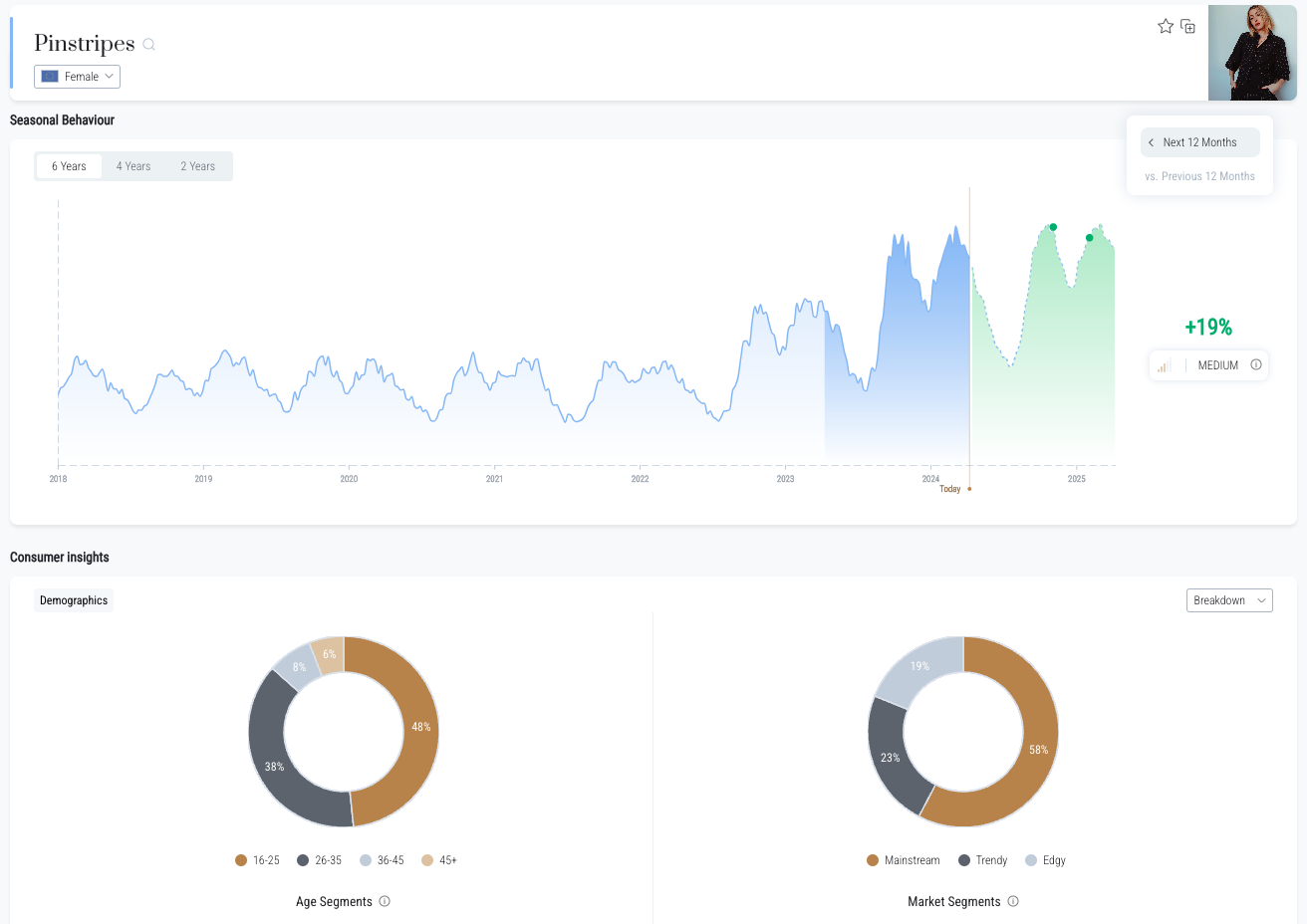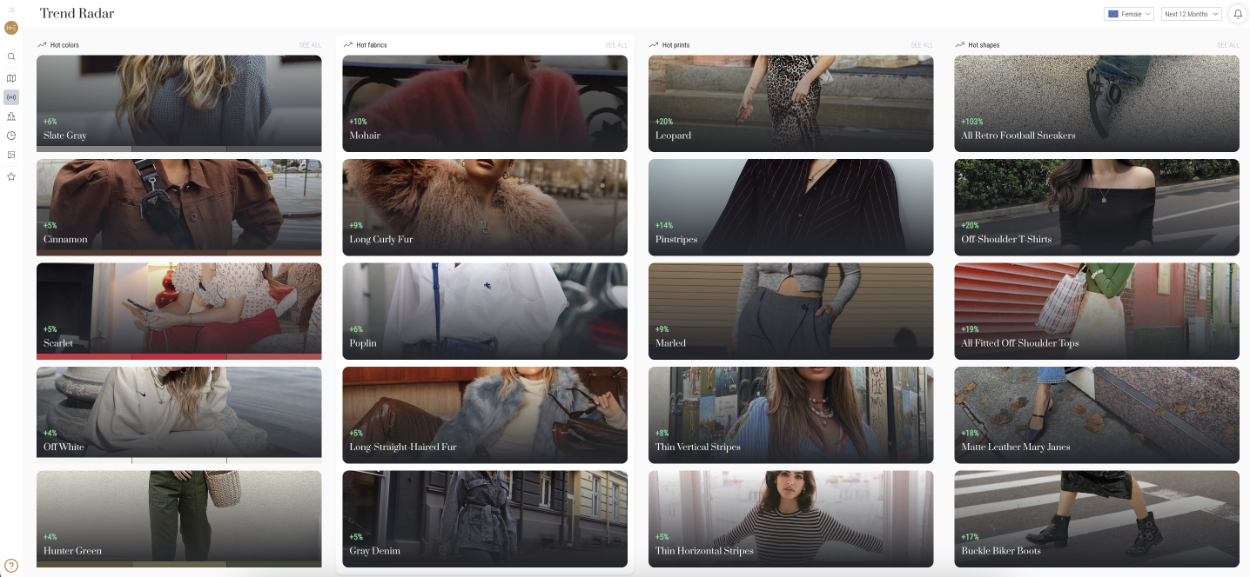Released in The Interline’s AI Report 2024, this executive interview with Heuritech is one of a fourteen-part series that sees The Interline quiz executives from companies who have either introduced new AI solutions or added meaningful new AI capabilities into their existing platforms
For more on artificial intelligence in fashion, download the full AI Report 2024 completely free of charge and ungated.
What’s your working definition of AI? Does it differ from the public understanding, which is currently dominated by large language models and generative text-to-image models? And how does that definition manifest itself in your solutions?
At Heuritech, we have been working with deep learning technology based on image recognition for over 10 years. AI helps us generate big data, but it differs from the AIs that are currently generating buzz. We use visual recognition to monitor fashion trends and market movements on social networks at a scale that is unattainable for humans. Our technology can recognize over 2,000 details of clothing and fashion accessories, and it does this across about 3 million images per day. In addition to this, we apply another type of algorithm that allows us to anticipate the behavior of trends in the future, currently up to a limit of one year, with 90% accuracy
As a company that has used computer vision and deep learning models behind the scenes for quite a while, Heuritech has a unique perspective on not just how AI can help people make better, more data-driven decisions, but also how far those deeper applications of AI have already transformed the way people in fashion interact with technology. What has that experience taught you about how the maturity curve for this new wave of AI is likely to progress?
The most challenging part of the journey seems to have already been overcome. A decade ago, few non-specialists were interested in AI, and even fewer in its application to fashion. Generative AIs, in particular, have completely changed the game because they provided a tangible, B2C use case. The evangelization by companies that have been operating in the AI space for a longer time has undoubtedly had a positive impact on the perception of these new uses. However, I believe this new wave of AI is likely to progress more quickly and may also saturate the professional and media landscape more rapidly. It’s crucial to be vigilant and avoid overwhelming the public to prevent a backlash and unrealistic expectations about the concrete contributions of these technologies. The more people talk about a topic without truly being experts, the more shape-shifting the topic becomes. This calls for a balanced approach in discussing AI’s capabilities and its realistic benefits.

Heuritech: Pinstripes Trend Detail & Forecasted Growth
Heuritech is also an interesting case study because you are already seeing how different teams – from designers to management – are working with the output of AI. In your experience of working with clients, how do those different teams benefit from AI individually and collectively? And how do you work with them to build trust in it?
The key is primarily to have a deep understanding of the industries for which AI is designed. Industry experts are needed to truly meet needs and especially to anticipate the recurring and natural questions of a product or collection development process. If the data resulting from the AI’s action makes sense to the teams, 80% of the job is done. The challenge is to teach them to make sense of unique data even though the backgrounds are very different among a designer, a merchandiser, a buyer, a marketer, or a communicator. Heuritech’s unique feature is that we bet on the fact that a single platform equipped with easily understandable and actionable data is the key to fruitful and smooth cross-team collaboration. Our efforts are entirely dedicated to this goal.
Contact with a team of hybrid fashion and data profiles is also a crucial point of reassurance for the client. And we created those jobs and profiles internally. Speaking the same technical language, whether in fashion or sportswear, establishes a trust link that allows us to take them further in analysis and thus in the use of data because they are on familiar ground… except that we add an extra layer of technology!
There is a lot of concern at the moment around the relationship between AI and creativity – with designers and a wide spectrum of other job roles fearing that AI could replace them. How do you believe individuals, and the industry as a whole, should be thinking about and preparing for the near future?
I believe that AI will not replace anyone (and I am confronted daily with its limitations), but I do think that people trained in using AI as a tool to optimize their human performance will replace those who do not get on board with this technological revolution. I think that in a few years, not knowing or even not being able to create a prompt could be as disabling as not knowing how to search for information on the Internet today. This may sound elitist and daunting, but I believe, on the contrary, that we have the power to act with a focus on education and access to training and information about AI to avoid the pitfalls experienced during the internet revolution, which left entire generations behind. With this experience, we can make AI a real opportunity to enhance our human capabilities. I sincerely believe that AI is the perfect tool to enhance our uniqueness as human beings, our creativity, our inventiveness, our spontaneity, our mental flexibility. I also think that all actions or productions that are exempt from AI could soon be overvalued, like some crafts, and bring real creativity back to the forefront, relegating the tepid uniformity we sometimes face due to a lack of creative daring.

Obviously there is a serious rush towards AI applications and solutions at the moment, and every business is figuring out how to effectively ride what feels like the next major wave of enterprise technology. But it’s equally important to recognise the current limitations of AI, and to acknowledge that there is not likely to be a “one size fits all” approach to it. How can brands and retailers find that pragmatic middle ground?
One should always be wary of the reflex ‘I was told I had to do something for the good of my company, so I do it without questioning and without really understanding.’ There are three keys to using AI sensibly and thoughtfully:
- What is my real need? Where do I feel a need for optimization?
- What type of AI is suited to my need?
- Which experts are truly capable of advising me or developing the solution I need or recommending a company whose business it is?
- The key is to research, take interest, and connect with the right actors.
AI is only useful if it meets a specific need and is managed by people who have the most accurate understanding of that need. If you want to train AI in image recognition for the world of decoration, find experts in decoration capable of guiding the training of said AI by engineers. If you do not have a sufficient budget to internalize, turn to a company that has the vertical that matches your offer or need. There are infinite possibilities in AI, and anyone who claims to have all the solutions to your problems with a single AI is either lying… or a genius.
What do you see as the near-term future of AI? Do you believe it will be a transformative class of technologies the way people expect? And what does the roadmap to value look like?
Difficult question, even for a trend forecaster! There is no magic crystal ball, but I think we are moving towards more concrete applications, greater simplification of models, and their wider distribution. I believe AI is becoming the norm for many professional processes across all job categories. I’m far from an expert, but on a more technical level, it seems to me that there is an increasing number of open-source programs and that the public is becoming more mature about the subject. I also think that popular BtoC applications will shift from recreational to increasingly utilitarian uses (even though our everyday objects are already equipped with AI). Finally, even though I use AI daily and have been passionate about the subject for many years, I think we are going to see a backlash against AI. More and more people are going to seek a return to more concrete, more authentic, human-first things, because we are in a period of searching for meaning and essentiality from which AI sometimes distances us.
